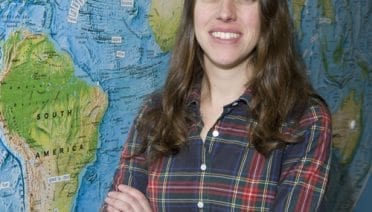Press Room
Neel Aluru, an Assistant Scientist in the Biology Department at Woods Hole Oceanographic Institution (WHOI), has received an Outstanding New Environmental Scientist (ONES) award from the National Institute of Environmental Health Sciences (NIEHS).
Intense hurricanes, possibly more powerful than any storms New England has experienced in recorded history, frequently pounded the region during the first millennium, from the peak of the Roman Empire into the height of the Middle Ages, according to a new study. The findings could have implications for the intensity and frequency of hurricanes the U.S. could experience as ocean temperatures increase as a result of climate change, according to the study’s authors.
Thirteen scientists from the Woods Hole Oceanographic Institution (WHOI) are featured in the new publication “Women in Oceanography: A Decade Later,” which reviews the progress made over the last 10 years in addressing barriers to career advancement for female oceanographers.
A new study led by scientists at the Woods Hole Oceanographic Institution (WHOI) points to the deep ocean as a major source of dissolved iron in the central Pacific Ocean. This finding highlights the vital role ocean mixing plays in determining whether deep sources of iron reach the surface-dwelling life that need it to survive.
Think of the Sahara and you will conjure images of a vast desert landscape, with nothing but sand as far as the eye can see. But for a period of about 10,000 years, the Sahara was characterized by lush, green vegetation and a network of lakes, rivers and deltas.
This “green Sahara” occurred between 14,800 and 5,500 years ago during what is known as the “African Humid Period.” Why and how it ended is the subject of scientific study that holds important information for predicting the region’s response to future climate change.
In a study published this week in Nature Geoscience, a team of researchers provides new insight into the behavior of the African monsoon at the end of the African Humid Period and the factors that caused it to collapse.
A common algae commercially grown to make fish food holds promise as a source for both biodiesel and jet fuel, according to a new study published in the journal Energy & Fuels.
The researchers, led by Greg O’Neil of Western Washington University and Chris Reddy of Woods Hole Oceanographic Institution, exploited an unusual and untapped class of chemical compounds in the algae to synthesize two different fuel products, in parallel, a from a single algae.
As the ocean ‘s pH decreases and acidifies, coral reefs are more likely to begin dissolving and “drown”. A new study shows exposing corals to added nutrients increases their erosion and dissolution rate tenfold.
The Commonwealth of Massachusetts has awarded the Woods Hole Oceanographic Institution (WHOI) a $5 million grant toward the construction of new facilities for the testing and research into innovative marine robotics such autonomous underwater vehicles (AUVs). The five-year grant award is being made as part of the Collaborative Research and Development Matching Grant Program, managed by the Massachusetts Technology Collaborative (MassTech). The grant to WHOI’s Center for Marine Robotics will help accelerate the deployment of new and existing marine robotics technologies in Massachusetts
A new study by researchers at Woods Hole Oceanographic Institution and their colleagues examined behavioral responses to sound by cuttlefish, a type of shell-less mollusk related to squid and octopi. The study is the first to identify the acoustic range and minimum sound sensitivity in these animals. Their findings, published in the Journal for Experimental Biology, can help decision makers and environmental managers better understand the impacts of noise in the ocean.
Scientists studying the harsh and rapidly changing Arctic environment now have a valuable new tool to advance their work—an innovative robot, designed and built at the Woods Hole Oceanographic Institution (WHOI) that is changing the way scientists can interact with and observe the polar environment.
Woods Hole Oceanographic Institution Senior Scientist Daniel Fornari has been selected to receive the 2014 Edward A Flinn III Award from the America Geophysical Union (AGU).
Woods Hole Oceanographic Institution Assistant Scientist Jessica Tierney has been selected to receive the 2014 James B. Macelwane Medal from the American Geophysical Union (AGU).
The Woods Hole Oceanographic Institution (WHOI) in collaboration with the Ocean Explorium in New Bedford, Mass., has created new digital content for museum-based spherical display systems that brings high-definition images and video of dynamic, deep ocean ecosystems to the public.
Woods Hole Oceanographic Institution (WHOI) Scientist Emeritus Dr. John (Jack) Whitehead has been selected to receive the 2014 Maurice Ewing Medal from the America Geophysical Union (AGU). The Maurice Ewing Medal is given annually to one honoree in recognition for…
The Alexander von Humboldt Foundation in Bonn, Germany, has recognized two Woods Hole Oceanographic Institution (WHOI) scientists with honors: Chris German received a Humboldt Research Award and Caroline Ummenhofer was chosen for a Humboldt Research Fellowship.
As California finally experiences the arrival of a rain-bearing Pineapple Express this week, two climate scientists from the University of Minnesota and Woods Hole Oceanographic Institution have shown that the drought of 2012-2014 has been the worst in 1,200 years.
Scientists call for maintenance efforts to be started now to avert the loss of vast expanses of coastline, and the consequent losses of ecological services, economic and social crises, and large-scale migrations.
WHOI life trustee Professor Robert Solow and former WHOI trustee Professor Mildred Dresselhaus have been awarded the 2014 Presidential Medal of Freedom.
Woods Hole Oceanographic Institution (WHOI), as a part of the Stantec Team, has been selected by an interagency scientific review panel to lead a long-term scientific study of the Arctic marine ecosystem along the Beaufort Sea shelf from Barrow, Alaska, to the Mackenzie River delta in Canadian waters.
The first detailed, high-resolution 3-D maps of Antarctic sea ice have been developed using an underwater robot. Scientists from the UK, USA and Australia say the new technology provides accurate ice thickness measurements from areas that were previously too difficult to access.





